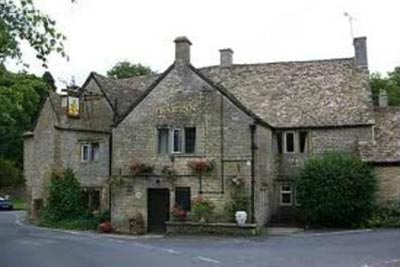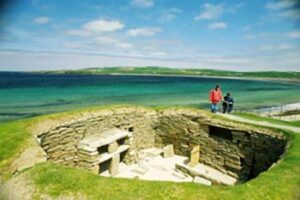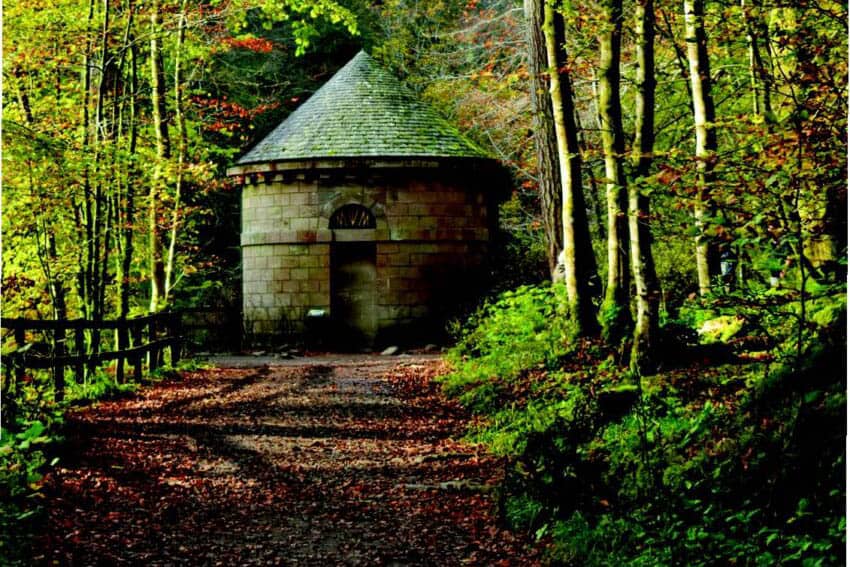
On a Victorian Tricycle, the Author explores the Highlands of Scotland
Paul Murton journeys the length and breadth of the spectacularly beautiful Scottish Highlands. In addition to bringing a fresh eye to popular destinations such as Glencoe, Ben Nevis, Loch Ness and the Cairngorms, he also visits some remote and little-known locations hidden off the beaten track.
Throughout his travels, Paul meets a host of modern Highlanders, from caber tossers and gamekeepers to lairds to pipers. With an instinct for the unusual, in The Highlands he uncovers some strange tales, myths and legends along the way: stories of Jacobites, clan warfare, murder and cattle rustling fill each chapter – as well as some hilarious anecdotes based on his extensive personal experience of a place he loves to call home.
Excerpt from the Book: Birnam Wood – an independent wheel man – Peter Rabbit and Mrs. Tiggywinkle
 The picturesque town of Dunkeld is another Highland gateway. It sits on the north bank of the Tay where the river narrows to a pinch point beneath high crags before flowing eastwards towards the Lowlands and the city of Perth.
The picturesque town of Dunkeld is another Highland gateway. It sits on the north bank of the Tay where the river narrows to a pinch point beneath high crags before flowing eastwards towards the Lowlands and the city of Perth.
The first time I explored Dunkeld properly was several years ago when I arrived in town on a Victorian tricycle. This was during the filming of the very first series of Grand Tours of Scotland.
To fully immerse myself in the project, I’d enthusiastically embraced the idea of traveling through the Highlands as early tourists had done, and I was keen to use various forms of period transport to experience the country from an authentic, historical perspective.
When I was presented with an original Rudge Lever Tricycle, manufactured in Coventry in the 1870s, I didn’t realize just how difficult and painful Victorian locomotion could be. I soon found out.
Pumping hard on the pedals, every bone in my body rattling, I bumped and swayed dangerously towards Dunkeld wondering what I would find. My 1886 copy of Black’s Guide was effusive: ‘There are few places of which the first sight is so striking as Dunkeld; its finely wooded mountains, its noble river, its magnificent bridge, and its ancient cathedral, combine to form a picture of rare beauty.’
I hoped so. All the effort I was expending demanded a substantial reward.
Avoiding cars and pedestrians without mishap, I negotiated the narrow streets of the old town center, rattled over the Cross where once markets were held and made for the cathedral – the most striking and historic part of Dunkeld.
Leaving my tricycle outside the iron gates of the cathedral grounds I was struck by the sight of a building made of two distinct halves: one ruined and the other a functioning place of worship.

There has been a Christian center on the banks of the River Tay at Dunkeld for close to 13 centuries. The original church is said to have been founded around AD 730 by Celtic monks.
A century later, after the kingdoms of the Picts and the Gaels were united, the church was rebuilt.
Shortly afterward, the holy relics of St Columba were brought from Iona to Dunkeld in order to protect them from marauding Vikings.
With Columba’s relics in safekeeping, the religious community beside the Tay flourished, becoming the center of Scottish Christianity.
The cathedral was built, rebuilt and modified over the centuries. Most of what can be seen today dates from the 13th century.
But the work of generations was destroyed twice – first during the Protestant Reformation of the 1560s, and then in August 1689 during the first Jacobite rising.
During the onslaught, much of the town was burnt to the ground, including the cathedral.
With Dunkeld a smoldering ruin, the Jacobites retired and disappeared into the hills. The eastern half of the cathedral nave was eventually roofed over and became a place of worship again. The rest of the building was left open to the heavens.

In a dark corner of the cathedral was the tomb I wanted to see. It dates from the 1390s and is one of the oldest royal monuments to have survived in Scotland from the Middle Ages.
On an elaborately carved stone platform lies the effigy of a knight in armor, arms crossed over his breastplate, his mailed hands pressed together as if in prayer.
This pious figure represents none other than Alexander Stewart, the notorious Wolf of Badenoch – one of the wickedest characters in Scottish history.
Alexander was born in 1343. He was one of the illegitimate sons of King Robert II, who had fathered a large brood of children to various women. When Alexander’s father married his mother, the bastard son of the king was retrospectively legitimized.
He was then sent to the wilds of Badenoch to rule the north of Scotland on behalf of the crown. Instead of playing the king’s ambassador, Alexander terrorised and pillaged much of the Highlands, earning him the sobriquet ‘the Wolf’.
How ironic then, that the godless Wolf of Badenoch now lies beside the High Altar in Dunkeld Cathedral in a tomb that bears the inscription: ‘Here lies a good man’.
Perched precariously on the uncomfortable seat of my Rudge Lever Tricycle, I set off across the bridge that spans the Tay at Dunkeld.
The present bridge was built by the Scottish civil engineer Thomas Telford and opened in 1808.
Previously, there had been at least one medieval bridge over the Tay, but like its predecessor it was destroyed by various ‘great floods’ over the years. For several decades, until Telford’s bridge was built, travelers wishing to cross the river had to take one of two ferries, which by all accounts was a journey that was sometimes fraught with danger.
In 1766, the East Ferry was carrying 13 passengers and four horses when an oar broke. The ferrymen momentarily lost control. The craft was swept downstream in the strong current until it hit a pier and filled with water.
In the chaos, the horses jumped overboard. Some passengers survived by holding onto them, the others were carried away by the river. Six were drowned.
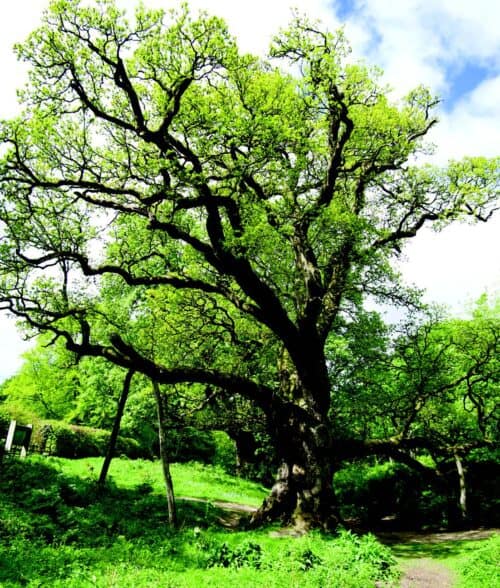
The village of Birnam today boasts an ancient tree – the Birnam Oak – which is said to be one of the last survivors of the Great Wood. To find it, I steered my tricycle through quiet streets, following signs to a location close to the south bank of the River Tay.
The tree is unmissable – an ancient, venerable specimen, its lower boughs propped up with wooden stakes, and its heart hollowed out and blackened by fire.
With a circumference of 24 feet, no one knows how old the oak really is, but it’s unlikely to date from the time of the real Macbeth, who lived over a thousand years ago.
It also stretches credulity to think that any army would have cut branches to conceal themselves before marching to Dunsinane.
What’s more, the real Dunsinane lies in the Sidlaw Hills 30 kilometres to the southeast.
That’s quite a hike with a tree on your back. Of course, it has to be remembered the real Macbeth is not the Macbeth we know from the eponymous play.
That’s the creation of Shakespeare’s imagination, which may have been fueled by his own theatrical tour of Perthshire in 1589. Perhaps Shakespeare saw the oak then, when Birnam Wood stretched into the hills on both sides of the Tay?
Not wishing to dice with death by crossing the busy A9 on my trike, I proceeded on foot to the Hermitage, which is just outside Birnam, on the River Braan. Sarah Murray was a visitor in 1796.
She had come from staying with kindly hosts who had laden her with gifts so that, ‘My chaise was crammed with provisions, wine and other good things for my use.’
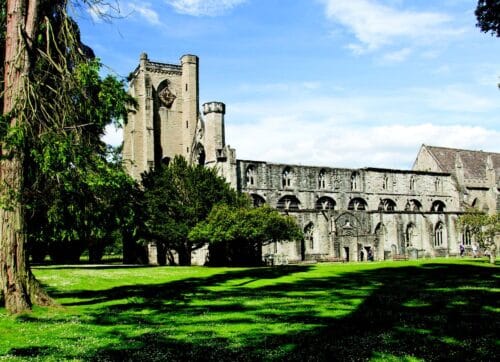
Sarah was on her way to experience the delights of one of Scotland’s very first tourist attractions: Ossian’s Hall, which stood, as it does today, above the ‘foaming rage’of the River Braan where ‘lofty projecting rocks were striving to kiss each other’.
Ossian’s Hall was built in 1782 by the Duke of Atholl to replace a summerhouse that was known as the Hermitage.
The building was designed to appear like a small temple and was decorated inside with plasterwork, a large painting of the blind, mythological poet Ossian and several mirrors.
These were set to increase the impact of the scene outside, where the river passes through a narrow gorge over the Black Linn Falls.
It certainly had the desired effect on Sarah Murray: ‘On entering, I was astonished. The contrast between the room, the beautiful cataract and its scenery, is beyond description striking!’
 Paul Murton is well known as a documentary filmmaker whose work includes Grand Tours of Scotland and Grand Tours of the Scottish Islands (4 series). He grew up in rural Argyll and has been an inveterate traveler since his teenage years.
Paul Murton is well known as a documentary filmmaker whose work includes Grand Tours of Scotland and Grand Tours of the Scottish Islands (4 series). He grew up in rural Argyll and has been an inveterate traveler since his teenage years.
Buy this book on Amazon: The Highlands
- Camino Tales: Wine and Memories in Galicia, Spain - July 25, 2024
- Beluga Hunting in Norway - July 20, 2024
- Costa Rica: A Rainforest Chocolate Tour - July 18, 2024




